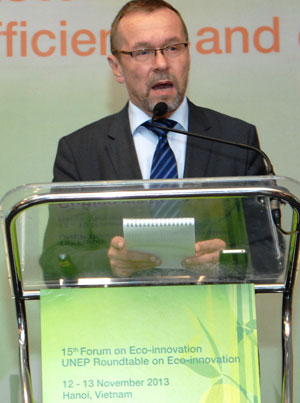Timo Mäkelä, an environmental expert at the European Union, on the scope for green business in Southeast Asia
By Christian Vits
Q: Do you see a beginning of an environmental thinking among Asean citizens? And what can be done to raise the awareness for green businesses?
A: Asean citizens are demonstrating a growing interest in environmental protection, which goes hand in hand with the environmental challenges faced by their respective countries. For the moment however, governments still have to increase their awareness-raising efforts. What they could focus on is raising awareness about the challenges and threats from environmental degradation and then to show the real economic opportunity behind eco-innovative solutions addressing these challenges.
Take Vietnam: for citizens’ awareness, Vietnamese authorities have recently become more proactive by encouraging initiatives like GreenBiz2013 or the Eco-Innovation Forum. The latter showcased numerous Asian initiatives spinning from businesses or cooperation programmes actively involving citizens in improving resource efficiency by reducing food waste. The high participation at both events indicates a willingness to better understand the dynamics of the green economy and the intention to reap its benefits.
Businesses are engaging in the green economy. Citizens are only just beginning to be receptive. It is now up to governments to create the framework conditions for them to act. In the research field, cooperation projects with the EU are already well-developed: Asean partners now participate in more than 100 EU research projects with a total budget of over $676.9 million. The platform ‘Sustain EU-Asean’ promotes exchange, twinning, training and pilot actions between Europe and Southeast Asia in the field of climate change, resource efficiency and raw materials.

Directorate-General Environment unit, European Commission
Q: Which sectors in Southeast Asia are best suited and most open and adaptive to green businesses?
A: What is great in the green business, and what is particularly true for eco-innovations, is that it offers opportunities in many different sectors depending on the cultural, geographical or economic situation. It is up to each country to focus efforts and exploit specific opportunities. In some cases, small adaptations can have big impacts.
When I think of Asean countries with a large share of their economy depending on tourism, a shift to eco-tourism could lead to important savings in terms of resources, namely water, energy and food. Other countries have opted for more responsible forest-management systems as a way to protect and enhance their timber industry and exports to gain a competitive advantage over less environmentally friendly neighbours. What strikes me in some developing countries is that they are somehow already implementing the concept of a circular economy because they re-use and recycle materials and appliances. And they are not necessarily doing it for environmental reasons but for simple economic reasons. In this, they could work as examples to many of our European consumers.
Q: What are the biggest obstacles for increasing the share of green businesses in Southeast Asia?
A: It depends on the perspective. European eco-innovative businesses looking to expand their markets in Southeast Asia are often faced with bureaucratic obstacles, similar to those that they were facing in Europe before the single market. Permits, licences and language barriers mean a longer time before profits are made across borders, and delays are often not sustainable for SMEs engaged in important investments. From the perspective of Asian businesses, the challenges come from finding a committed and skilled labour force and
a receptive market.
Q: What’s the growth potential for green business in Southeast Asia and what development do you expect in the coming five years?
A: The growth potential is immense. Developing countries in Asia contributed significantly to global GDP growth over the last decade. And this, despite large disparities in national economies, a population density 1.5 times the world average and the availability of 40% of global land for 2/3 of the world population. In the future some of these figures are going to grow. With a fast-growing middle class becoming richer, consuming more and using more resources, it has been projected that in 2050 Asia will provide more than half of global growth.
One of the biggest challenges faced by Asean countries will be to trade off between resource efficiency and poverty alleviation, long-term versus short-term needs. Investing in green technologies and eco-innovative solutions can indeed help in this respect. EU engineers, for example, are at the cutting edge of technology in waste management, water supply, wastewater management and recycled materials.
These are areas where Asian countries have needs and are still lagging behind. However, if non-EU manufacturers can now make solar panels a lot cheaper than Europe, the US and Japan, this is because the whole supply chain is now available in their countries. Given the type of environmental problems faced by most Asian countries, I would not be surprised if Asean countries and businesses will focus their efforts on the sectors mentioned above to catch up on their European colleagues and develop national solutions to improve their commercial balance and offer better conditions to its population.

